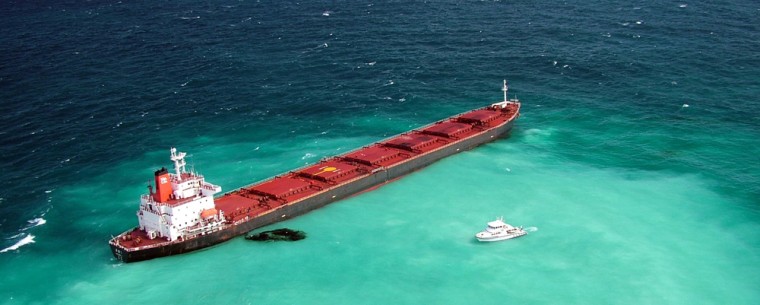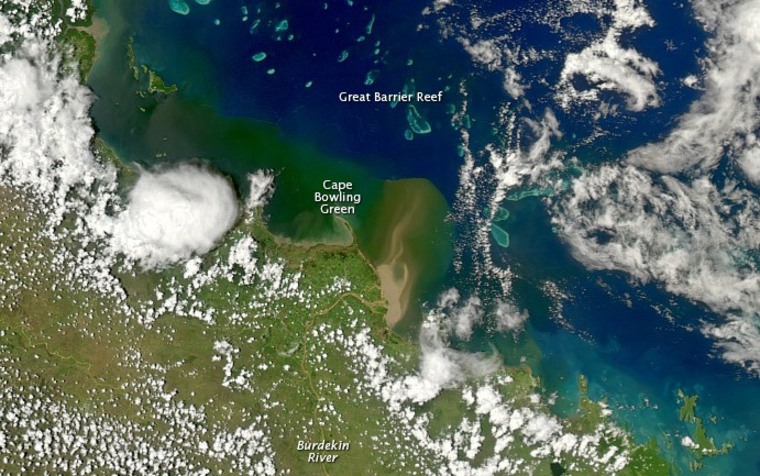Armed with water samples and historical flood data, Australian researchers are warning that the massive flooding in Queensland State is also impacting a neighbor: the Great Barrier Reef.
Already a huge pile of sediment has been dumped by the Burdekin River into waters at the southern end of the massive reef.
Besides top soil, that sediment contains pesticides and fertilizers. The combined effect of all that outflow could be dead coral.
"Our work has shown that high levels of nutrients and sediments can reduce coral diversity and increase the cover of seaweeds on inshore reefs," Katharina Fabricius, a researcher at the Australian Institute of Marine Science, told msnbc.com.
While the flooding across Queensland is the worst in 50 years due to multiple rivers overflowing and some 40 communities swamped, the specific flooding along the Burdekin is not even the worst there in recent years. "The two floods in 2009 and 2008 were among the largest ones on record," Fabricius said.
A team from the institute will be going out to part of the reef next week to check for impacts, she added, noting that the river on average carries more than three million tons of sediments into the reef every year — much of it soil eroded by cattle grazing along the river.
A NASA satellite image of the area on Jan. 4 "shows nicely how the sediment drops out — to be resuspended again on windy days, reducing water clarity — and how the nutrients are leading to algae blooms (water changes from brown to green)," Fabricius said.
Moreover, previous large floods along the Burdekin, one of several rivers that have flooded in Queensland, have led to outbreaks of a starfish that can overtake reefs.
"The timing and location of the three observed outbreaks of crown-of thorns starfish in the past have all coincided with the the times and place where the three largest Burdekin floods on record have impinged on the reef," Fabricius earlier told The Australian newspaper. "These outbreaks of coral-eating starfish are still the greatest source of coral mortality on the Great Barrier Reef."The sediment can also affect seagrass beds, causing some marine life to starve, and can trigger stress events that can lead to coral die-offs.
"You get very stressed corals, you get stressed sea grass," Michelle Devlin, a researcher at James Cook University in northern Queensland, told the news agency AFP.
"So let's just say that a big cyclone came along, knocked them all out. They might not recover so well because they are already very stressed," said Devlin, who has been taking samples of the river and tracking the plume.
She described the mix of water, nutrient-heavy soil and pesticide run-off as a harmful "cocktail" for the corals.
"There is just going to be this cocktail of water containing a lot of things that they (the corals) wouldn't necessarily have seen before. It is fresh, warm water and that will stress corals out as well."
While most rivers are receding, the dirty water will pour into the reef for weeks, enabling the plume to extend for hundreds of miles, she said.
The plume is already at the Keppel islands north of Rockhampton, Devlin said. "I think the Keppel reefs... they will have quite high mortality," she said.
Adding insult to injury, those islands last year were the scene of where a ship struck a reef, causing a small oil spill and damaging some coral.

Delvin said it was too early to know what impact the flooding would have overall on the 12,600-mile-long Great Barrier Reef Marine Park.
"This is a really massive event," Devlin said. "It has the potential to shift the food web, it has the potential to shift how the reef operates."
Like many other reefs around the world, the Great Barrier Reef has had pressure from run-off, sewage and more recently warming seas tied to climate change.
The Great Barrier Reef saw severe bleaching in 1998 and 2002 — the two hottest summers on record there.
